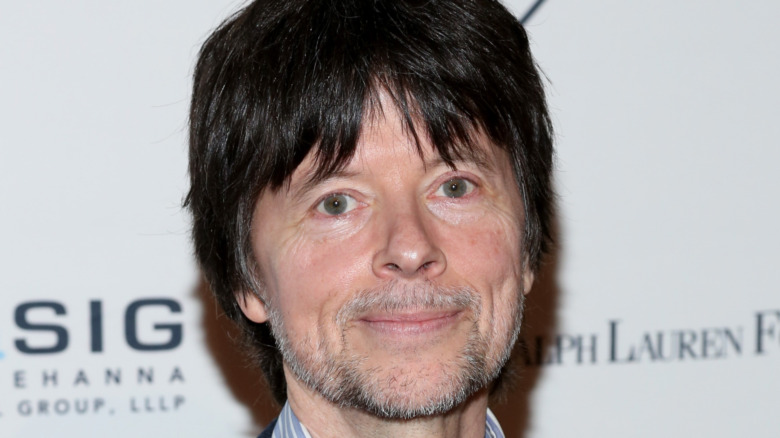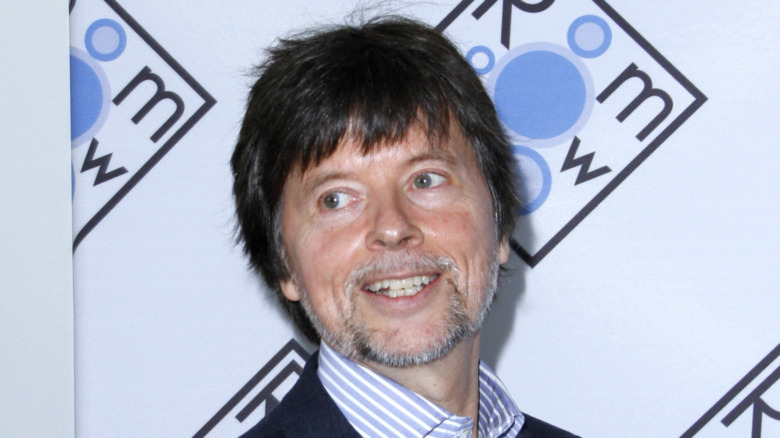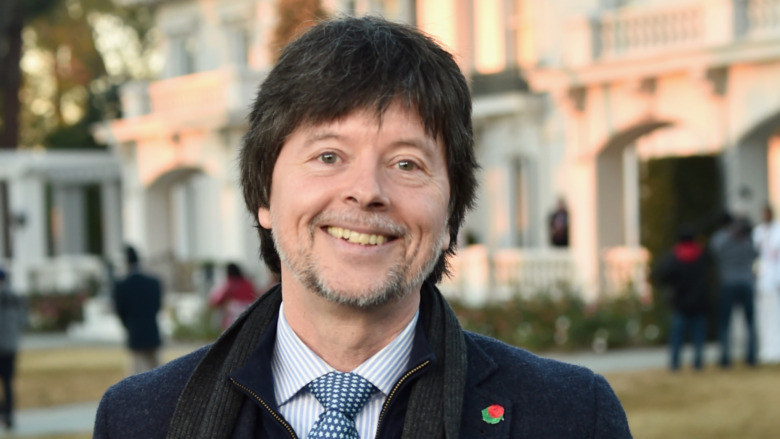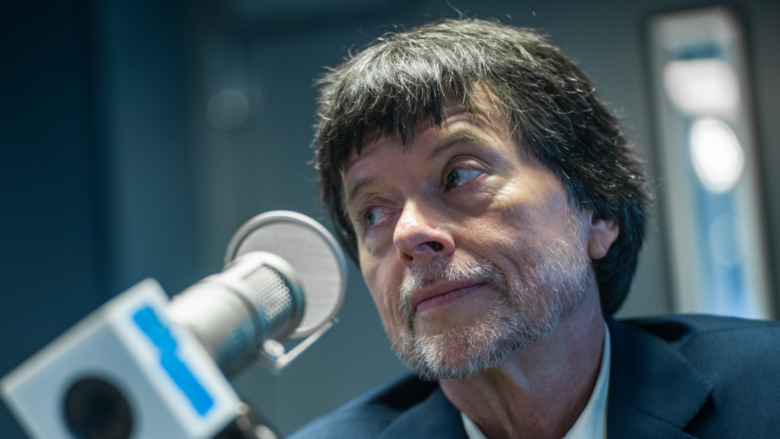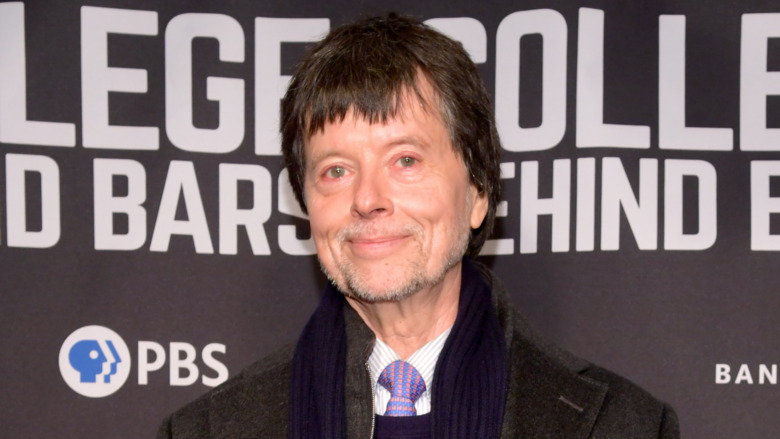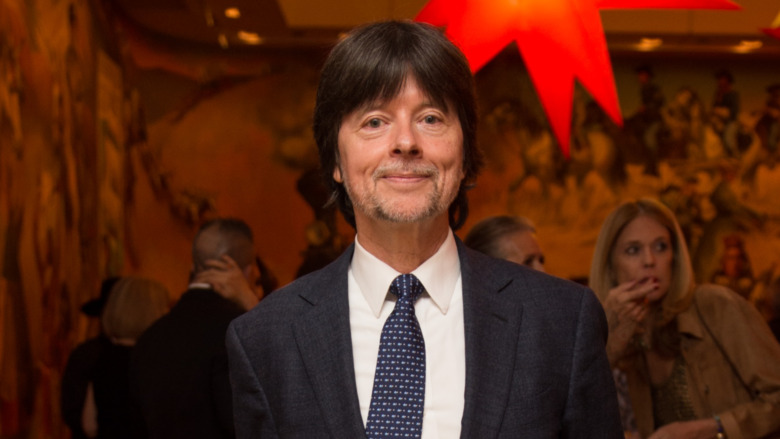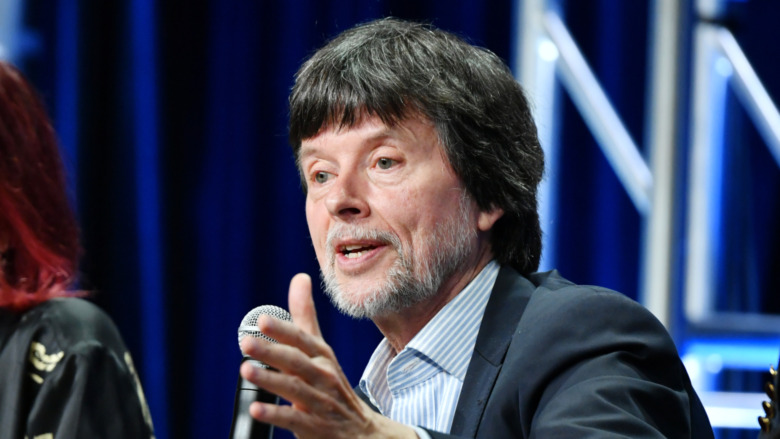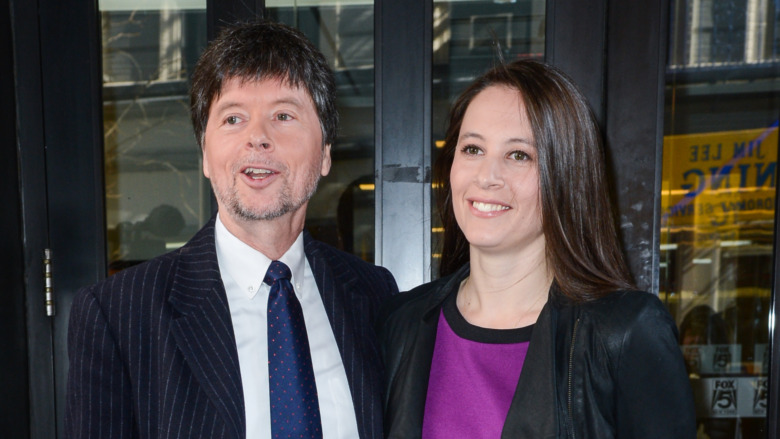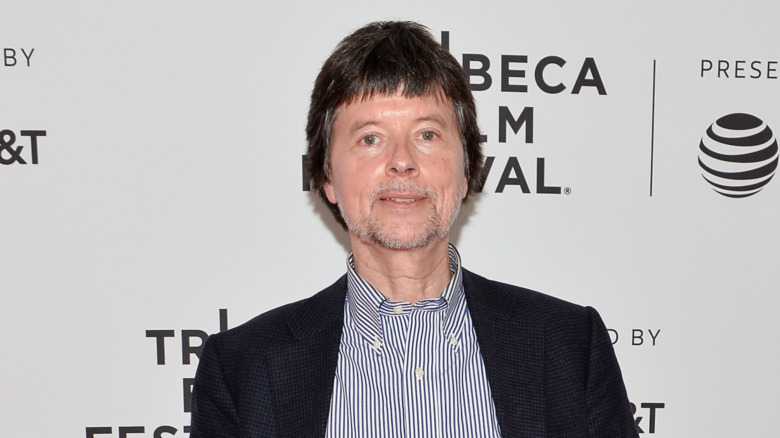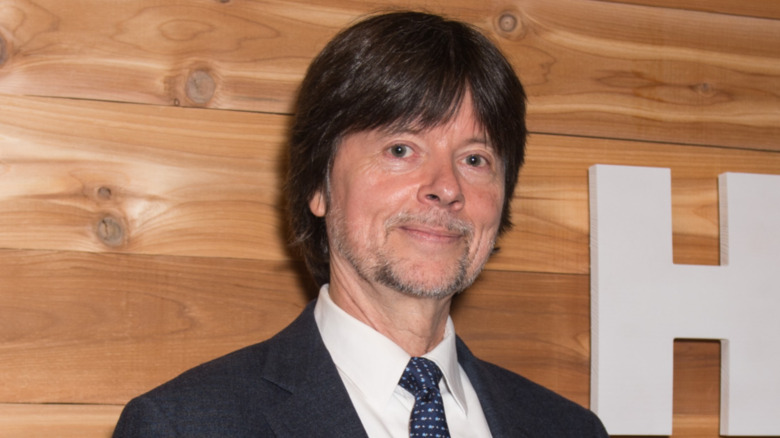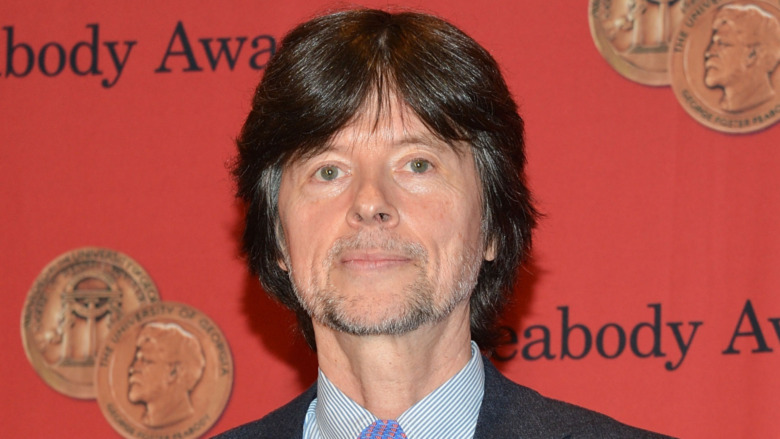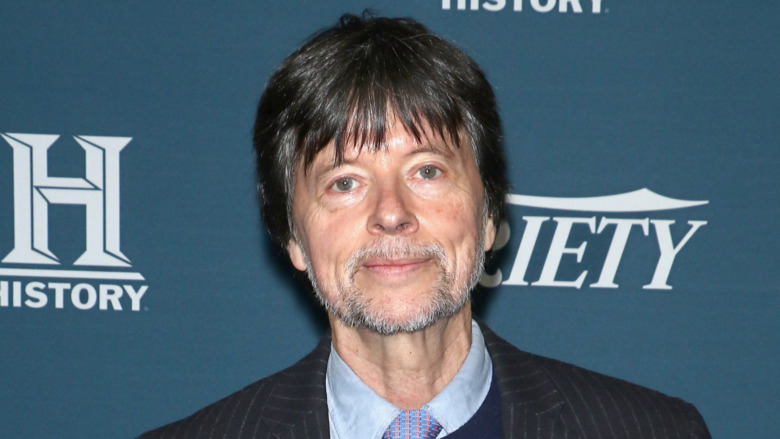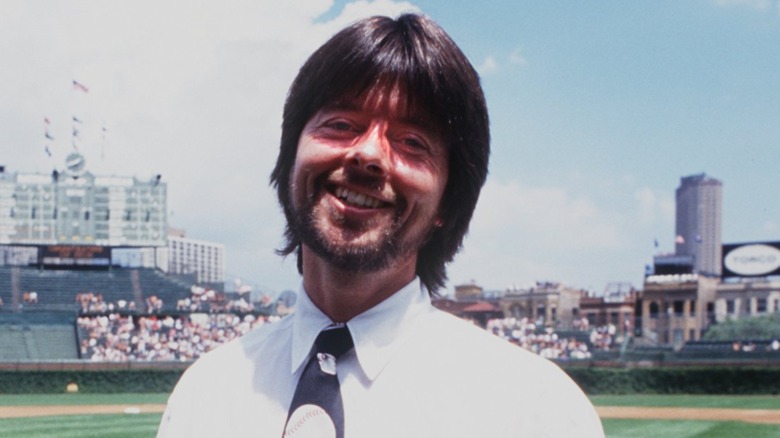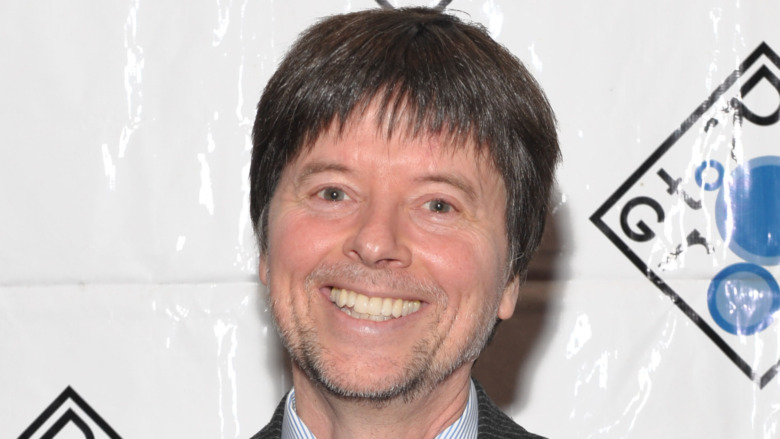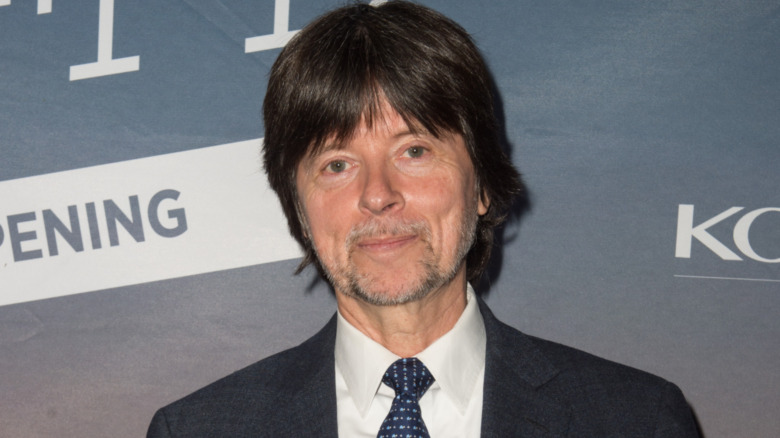The Untold Truth Of Ken Burns
As one of the biggest stars in the documentary film world, Ken Burns earned this reputation through quantity and quality. He's been working in the industry since the '70s and shows no signs of slowing down. In addition to over 30 honorary degrees, Burns is also well respected by his peers in entertainment. He's been twice nominated for an Academy Award and holds sixteen Emmy Awards, according to his website. And in 2008, the Academy of Television Arts and Sciences awarded Burns with a Lifetime Achievement Award. But he didn't stop after the great honor and continued releasing films about once every year. As of 2021, Burns created over 30 documentaries released over forty years, with several more in the works. "Burns is not only the greatest documentarian of the day, but also the most influential filmmaker period," David Zurawik wrote for The Baltimore Sun. He added that "Burns not only turned millions of persons onto history with his films, he showed us a new way of looking at our collective past and ourselves."
Burns' real life has been filled with triumphs and struggles. From a difficult upbringing and rocky relationships, to commencement speeches, the filmmaker seems to have as much personal history as the historical content that goes into his movies. Plus, a distinct physical trait and a peculiar obsession to keep people intrigued in the man behind the camera.
PBS fans and documentary buffs get ready because this is the untold truth of Ken Burns.
An early family tragedy for Ken Burns
Ken Burns was born in Brooklyn in 1953. Fitting that his first documentary he directed and produced for PBS was called "Brooklyn Bridge." When Ken was still a toddler, his parents had a second boy named Rich Burns. Though he now had a brother, Ken's childhood would not be easy.
Ken and Ric's mother, Lyla Tupper, was diagnosed with cancer when they were kids. During a commencement speech at Stanford University, Ken vividly recalled an interaction he had with his mother when he was nine years old. While in tears, she told him and his brother "that she would be dead of cancer within six months." He added that one of her biggest worries was that "our inadequate health insurance had practically bankrupted us." She died when Ken was 11.
During a sit-down with San Francisco Focus, an interviewer asked Ken about the effect of losing his mother at a young age. He revealed that her body was cremated after dying but because the funeral home went out of business, "my family never got her ashes. So last year, my brother and I finally tracked down her ashes." He said this moment provided a sense of closure because according to the filmmaker, "I had been keeping her alive in some way." But Ken has always kept his mother in mind when making movies and said his film career has been a tribute. "All my films are about her," he said.
Ken Burns and his brother grew up 'running the show'
Ken Burns' father, Robert Burns, was an anthropologist and professor — and his line of work meant moving around a lot. After the family landed in Ann Arbor so Robert could teach at the University of Michigan, Ken's mother died, and he and his brother were mostly independent. Ric Burns told The New Yorker that he and Ken were raised by "a dying mother and a mentally ill father," the latter of whom may have had bipolar disorder. According to the publication, their dad "spent four months in a mental institution" when they were kids.
Ric told The New Yorker that he and Ken "were running the show — we were more parents than my father." For example, when the boys were in high school, their father left the country to go on a months-long research trip. "He left a checkbook; Ken paid the bills. This upbringing created unusual freedoms," Ric recalled.
If you or someone you know is struggling with mental health, please contact the Crisis Text Line by texting HOME to 741741, call the National Alliance on Mental Illness helpline at 1-800-950-NAMI (6264), or visit the National Institute of Mental Health website.
Nobody knows history like Ken Burns
Fans of Ken Burns know that his films focus on retelling history instead of crafting original storylines. All of his documentaries go into careful detail about the subject matter. This includes a wide range of topics like the Brooklyn Bridge, baseball, congress, and the Statue of Liberty. And some of his films go even deeper than others. For example, his famous work, "The Civil War," contains almost twelve hours of content. Speaking with Weber Studies, Burns admitted that during the editing process, he was worried that the long series would scare off most viewers. But Burns knew that such an important part of history deserved to be fully explained.
"I remember always being interested in non-fiction as opposed to fiction," he said in the interview. Burns recalled that as a boy, he consumed plenty of books. But he explained that his parents would mainly gift him nonfiction works like "encyclopedias and biographies." Meanwhile, his younger brother received all the novels. Burns said that his interest in history is mainly because of his "own family history. Being aware of the mortality of my mother, who was sick, and also feeling that in some way by understanding history perhaps you could abolish its merciless outcome."
Ken Burns reveals his love for photography
After high school, Ken Burns had his sights set in the entertainment business. He wanted to be a successful filmmaker in Hollywood, among other successful movie directors. Burns decided to study and learn his craft In Amherst, Massachusetts at Hampshire College. But after arriving on campus, he learned that storytelling doesn't always involve original content. "All my teachers were social documentary still photographers who reminded me there is much more drama in what is and what was than anything the human imagination could think of," Burns remembered in an interview for Weber Studies. Thanks to his teachers, Burns turned his focus and passion towards documentaries. "All of a sudden I have a relationship to still photography that isn't just a MTV generation way — which is physiologically received," Burns explained. According to the director, his goal was to reach audiences in a subtler, "more long-lasting" way. And he accomplished this by using "the power of the individual image to convey complex information without undue manipulation."
Burns explained that audiences and people in general most enjoy long relationships. Therefore, he needed to explore a similar relationship with photographs to use for documentaries. Instead of just one shot of a photograph, he would explore different angles and techniques of the same photograph. And Burns would also "listen to the photograph and wonder what accompanying sound effects should be used."
The ups and downs of Ken Burns' love life
Ken Burns married Amy Stechler and the two created documentaries together. In the '80s, the two released movies such as "The Shakers" about religious dancers and "Brooklyn Bridge," according to the Ken Burns website. But off camera, things weren't going as smoothly together. Burns and Stechler had two children together but ultimately separated. And according to the New York Post, Stechler left Burns when their two daughters "were little leaving him to raise them, for the most part, on his own, as well." Burns remembered learning how "to shop and buy party dresses for his little girls, while spending years carrying a torch for Amy."
Burns ended up finding love again and in 2003, he remarried Julie Deborah Brown. His second wife was a nonprofit organization founder based in New York, per The New York Times. The two wed in New Hampshire at their home. The couple had two daughters together, bringing Burns' total to four girls. But sadly, this marriage also didn't last. As The New Yorker put it, he had "troubled thoughts" after his second divorce, but he told the publication it helped in other ways. According to the filmmaker, after separating from Brown, the bond with all his children "quadrupled in their intensity and love and intimacy."
As of 2020, Burns appeared to be single, according to an article by The Hollywood Reporter.
Ken Burns reveals his thoughts about COVID-19
For a man who's dedicated much of his professional career to studying historical events, Ken Burns certainly can spot a major moment for the world. During an episode of The Hollywood Reporter's "Awards Chatter" podcast, Burns discussed the impact of the coronavirus. "COVID has immediately taken its place alongside the three great crises in American history, making it the fourth," he said. According to Burns, his list also included the Civil War, the Great Depression and World War II. This is a big existential moment." At the time of the interview in the summer of 2020, much was still unknown about the virus and its impact. "We are living through history," Burns explained. "We don't know how it's going to be, how long it's going to last, how virulent it will be, whether there will be any effective treatment, whether there will be an effective vaccine, how often we'll have to do this — there are a huge number of unknowns."
As a result of COVID-19 restrictions, things weren't all negative for Burns. He spent his quarantine days at home in Walpole, New Hampshire, with his two youngest daughters who were home from boarding school. In addition to spending "a lot of time out in nature," Burns also found time to create more content. This included working on eight films that he was developing.
Ken Burns has a big family
Ken Burns is the proud father of four daughters. At the time of a 2017 interview for Fatherly, his two oldest were in their 30s, his second youngest 12 years old and the youngest seven. "I do two things really well," he explained, "I'm a pretty good filmmaker and I'm a pretty good dad." Even though Ken lives in New Hampshire and his daughters in Brooklyn, he explained their close connection. According to the filmmaker, "it's a rare day that I don't talk to at least three, if not four, of my daughters every single day."
He often works with his daughter Sarah Burns and her husband. For example, she wrote the non-fiction book "The Central Park Five: The Untold Story Behind One of New York City's Most Infamous Crimes" and directed "The Central Park Five" — the documentary based on the book — alongside her father, according to The New Yorker. Burns' second-eldest, Lilly Burns, also followed in the entertainment industry. She worked behind the scenes as a producer on the Comedy Central series "Broad City."
Burns once created a charming comparison between his children and his movies. Just like all of his documentaries and all his daughter, Ken doesn't choose one over the rest. "I'd like to say that I love them the same," he told Weber Studies.
The special effect named for Ken Burns
Apple users might recognize the name Ken Burns from a piece of software. On the iPhoto app in the computer company's software suite, there is a special feature called the Ken Burns Effect. When selecting this option to playback a series of photos, the images seem to have a new life with dynamic movement. As The New York Times put it, the Ken Burns Effect "incorporates slow, portentous zooms and pans into otherwise ordinary slideshows of family snapshots," which is a style of filmmaking that Burns uses in his many documentaries. As he told NYT, Jerome Liebling, a well-respected photographer who became a professor at Hampshire College, was a major influence on his aesthetic — and also happened to be one of Burns' teachers.
Burns remembered that Liebling taught him "to realize how still photographs could be incorporated powerfully into documentaries." And he revealed that "the essential DNA of all my films issues from still photography." This special effect that Burns went on to popularize simply extended the viewer's experience with an image. According to the director, "sometimes you have to just slow down and look."
How Ken Burns became a filmmaker
As Ken Burns recalled in an interview for Weber Studies, his father enforced "a strict curfew" when he and his brother were kids. But the one exception, which helped transform Burns' curiosity, was freedom to watch films. In the aforementioned interview, he shared that he could attend "whenever there was a movie playing at the local cinema or at the University of Michigan where they had a great cinema program." And at home, his father would let him push the limits to consume more movies. Burns distinctly remembers, "I would sometimes be able to stay up to watch a movie on TV — sometimes until two in the morning," even on school nights. He would watch Western flicks like "Rio Bravo" starring John Wayne. And he remembered watching musicians too, like Ricky Nelson and Dean Martin. Burns credits his dad to letting him become so engulfed in these fantasy worlds. "So, I set my sights on being a Hollywood film director. All through high school that's what I wanted to be," Burns shared.
As a viewer, his favorite film ever is "Seven Samurai" by Akira Kurosawa. The 1956 classic clocks in at over 200 minutes, but Burns told Weber Stories that it "goes by in a nano-second to me." He said that the tale of Samurai protecting the village "is just one of the most humane and loving films I've ever seen, and at the same time it's got some of the greatest battle sequences of any film ever made."
The political side of Ken Burns
Among the many American subjects that Ken Burns studies, he is especially interested in politics and political figures. And he is unafraid to be both an outspoken champion and critic of different politicians. As The Washington Post noted, Burns supported democratic candidates Al Gore and John Kerry in the New Hampshire primaries. Then in 2007, Burns endorsed Barack Obama as he campaigned to become the democratic president elect. The filmmaker told The Washington Post that Obama "is presenting a vision for the future that is not only possible but essential to our survival as a nation." Burns continued that he believed George W. Bush's successor was original, authentic, and "someone who is able to dream, someone who is able to suggest a future that isn't so completely tied to the past." And he even compared Obama to one of the most famous presidents ever, Abraham Lincoln.
Years later, Burns found himself less happy with another president. During Burns' 2016 commencement speech at Stanford University in California, he expressed his concerns about the commander-in-chief at the time, Donald Trump. In the transcript from Stanford, Burns said that "as a student of history, I recognize this type" of leader. He described the president as someone "with zero experience in the much maligned but subtle art of governance; who is against lots of things, but doesn't seem to be for anything, offering only bombastic and contradictory promises." Burns urged students at the end to vote.
Ken Burns' favorite thing to collect
As someone who helps immortalize Americana in his documentaries, it makes sense that Ken Burns would like to collect tangible memories. And some particular items of American history that the filmmaker loves to collect are quilts. As of 2018, the filmmaker owned a total of 75 quilts, according to The New York Times. He reportedly started to buy American quilts in "the mid-1970s, often on prowls through antique stores on the back roads of New England." And yes, there is one quilt that is a cut above the bed, er, rest. He told the outlet that his favorite is called the "Circular Wreath," which he keeps above his bed in Manhattan. "I don't have a quilt that gives me more pleasure than this one," he said.
Burns' collection is so impressive that The International Quilt Study Center and Museum in Lincoln, Nebraska asked him to borrow a few. The museum launched an exhibit in 2018 called "Uncovered: The Ken Burns Collection" to show off 28 quilts that Burns lent. "Putting the quilts up permits other people to have their own associations. Like free electrons, they'll bounce off each other, and something will happen," Burns explained to The International Quilt Museum. He added, "I'm interested in the kinship that happens from the way television shows and quilts bring people together."
The truth behind Ken Burns' hair
For being known as the mastermind behind the camera, Ken Burns also is easily recognizable in front of the camera. Part of this is due to his divisive but unmistakable hair. As The New Yorker pointed out, the director sports "an unusual mass of collar-length hair, which resembles the removable piece on the top of a Lego figure." According to the article, Burns went to a hairdresser in 1975 to go from a long-haired style to something shorter. And since that cut, Burns has exclusively used the same hairdresser. "Never has so much hair meant so little to so many people for so long a time," Burns told GQ in an interview. "The very first notices I was getting with my first film on PBS, back in the early eighties, people were talking about this Beatle-haired, mop-top whatever," Burns said.
The filmmaker also confirmed that his hairstylist of choice is no urban legend. As GQ noted, he indeed has only been to the same spot to get his haircut "since 1975, the month after he graduated college." Burns explained that his hairdresser was first at one shop, and when she left, Burns followed. "She has since retired from her business and for the last ten years has been at home, but I've gone to her home," he shared.
Ken Burns is a charitable man
Though Ken Burns helps America by sharing his detailed documentaries, the director also gives back in other ways. He is involved with curating and supporting the arts. For example, helped found The National Willa Cather Center in Red Cloud, Nebraska. The goal of the center was to showcase and inform visitors all about Willa Cather, an American writer. And to help get the center open, Burns became "the honorary national chair for the Center's public fundraising effort," via The National Willa Cather Center website. According to the filmmaker, the site would serve as a museum dedicated to Cather's "most personal treasures, items made famous in her stories, and artwork inspired by her vision of the prairie." He also noted that for scholars visiting the location and archive, "it will be a chance to explore, firsthand, some of her most insightful original works and papers."
Burns also helped with another type of museum, one dedicated to music. According to Rolling Stone, after completing his documentary called "Country Music" for PBS, Burns donated a large amount of content to the Country Music Hall of Fame and Museum. He gifted a copy of every interview and transcript from his project to the museum. "They belong to our country," Burns said about the content. The documentary reportedly "was filmed over the course of eight years and was culled from 175 hours of interviews with more than 100 subjects."
How much is Ken Burns worth?
Ken Burns is easily one of the most prolific filmmakers in the entertainment industry. His body of work is enormous, including over 30 directing credits and over 40 producing credits per Burns' IMDb page. And with his huge library of work also comes a huge net worth. As of 2021, Burns was worth an estimated $1.5 million, according to Celebrity Net Worth.
While this might seem like plenty of money, some of Burns' friends didn't think so. One of his most famous buddies, Apple founder Steve Jobs, felt Burns didn't receive the proper compensation for his documentary work. In an interview for CNBC, Burns recalled a funny story about the late computer genius. Reportedly, Jobs felt Burns wasn't getting paid enough at PBS. "He had his lawyer, you know, talk to my lawyer," Burns said about Jobs. But after reviewing Burns' setup at PBS, Jobs conceded and said, "I think you've got a good deal. I think ... you've got this nice niche and you're protected."
In addition to his nice PBS deal, Burns is also in the restaurant business. Since the start of the new millennium, he's been part owner of a French and American restaurant in New Hampshire, according to Travel and Leisure.

